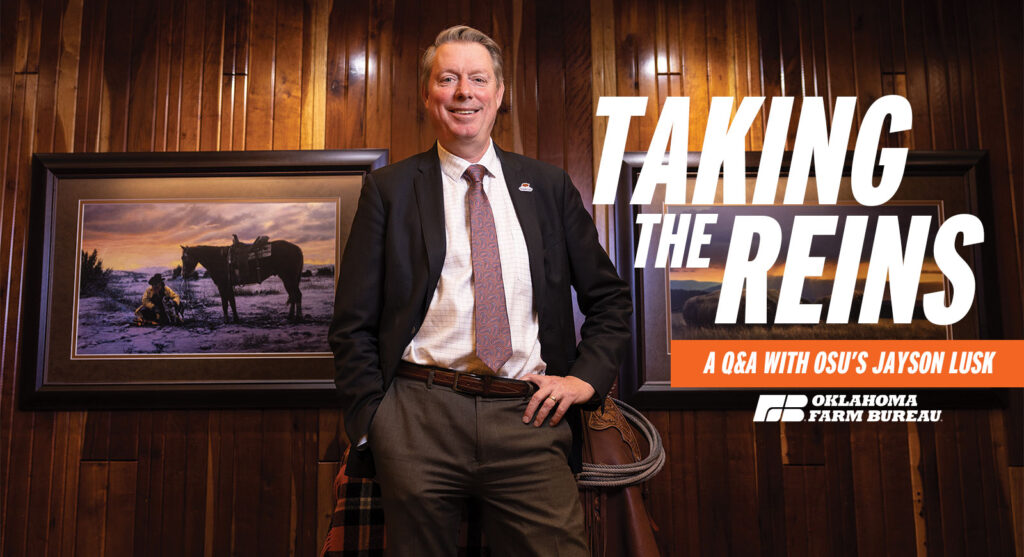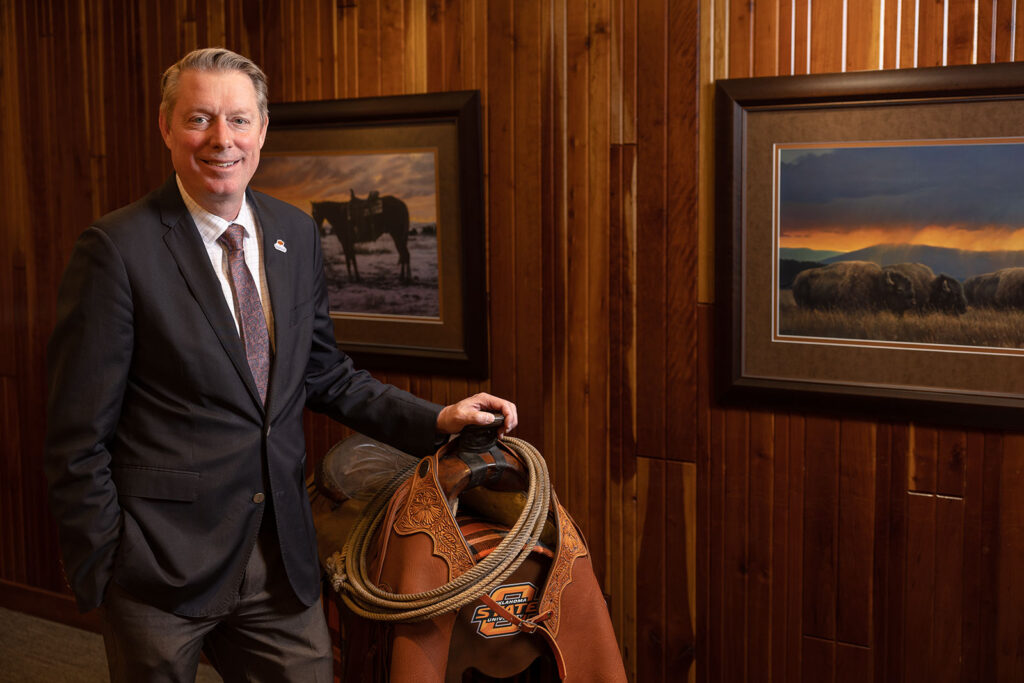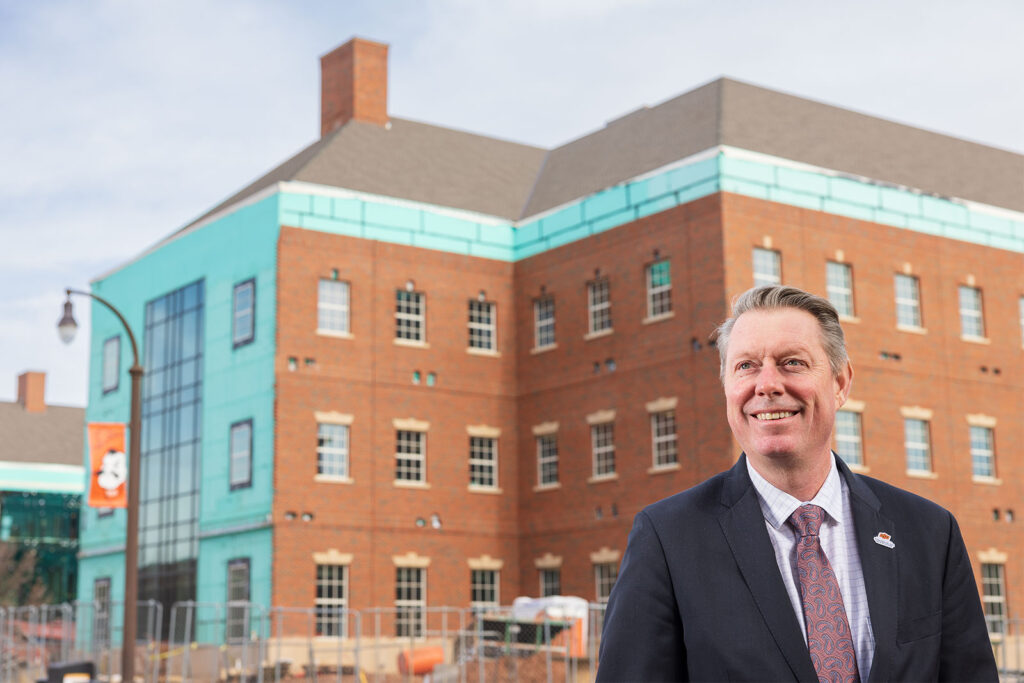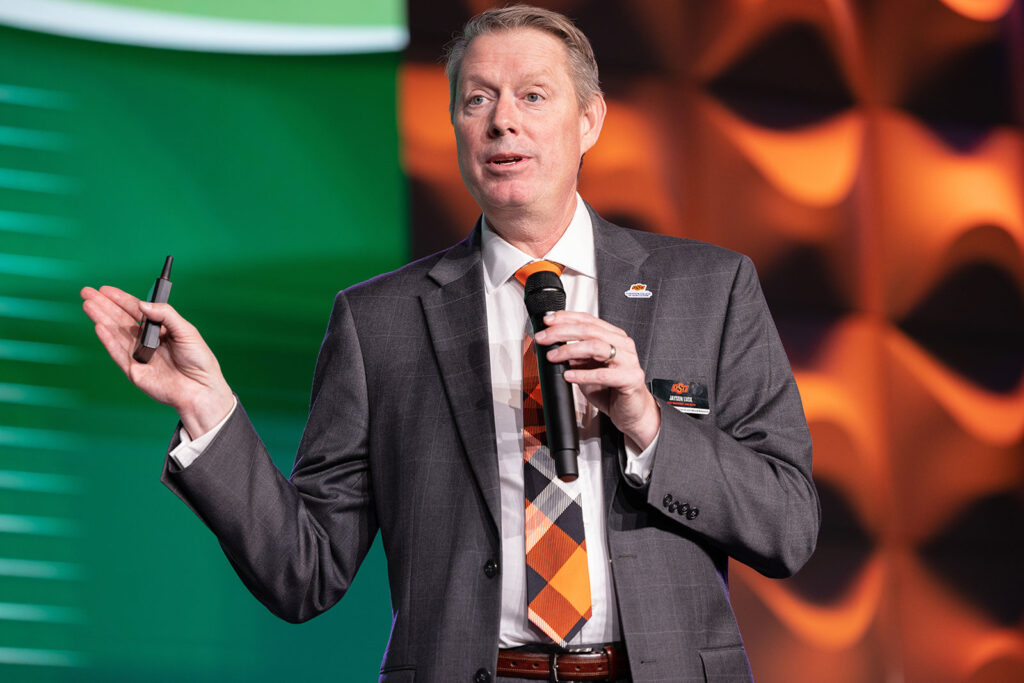
A Q&A with Jayson Lusk, Oklahoma State University vice president and dean of agriculture, on his vision for the future of OSU’s agriculture teaching, research and extension.
Photos and story by Dustin Mielke
There is a buzz of activity in and around Oklahoma State University’s Agricultural Hall and the surrounding buildings that comprise the Division of Agricultural Sciences and Natural Resources.
From the bustle of student-filled classrooms and hallways to agricultural research taking place in labs and on-campus farms to the construction crews working on the new flagship agriculture building that has risen from the red Oklahoma soil over the past year, OSU’s agriculture division continues to grow and innovate.
Jayson Lusk stepped into this world of bustling activity in August 2023 as the vice president and dean of the Division of Agricultural Sciences and Natural Resources. The West Texas native returned to OSU after a previous tenure in the university’s agricultural economics department from 2005-2017 and a diverse academic background that spans institutions of higher education, including faculty positions at Mississippi State University and Perdue University.
As the new head of OSU’s agricultural teaching, research and extension endeavors, Lusk begins his time as dean and vice president in a time of change and transition both on campus and off.
Oklahoma Farm Bureau had the opportunity to sit down with Lusk and visit about his vision for the future of OSU’s agriculture division, which impacts OKFB members and Oklahomans from all walks of life through a myriad of programs, efforts and educational activities.
Q
What drove your decision to return to Stillwater to lead OSU agriculture?
First, it is a place we previously lived, and where we enjoy living. Part of it was a personal reason that we enjoyed living in Oklahoma. We enjoyed the community here, and we enjoyed the culture of the state – all of that was important to us.
I wouldn’t do this job just anywhere because I think these are big jobs and important jobs that are almost 24/7 in terms of your responsibility. I knew if I wanted to give this job what I think it takes to be successful, I need to be able to do that at a place I care about, not just any place. OSU is a place where I can give it my all, where I can spend nights and weekends trying to promote the work that we do and garner resources for the work that we do here.
More substantively is that I feel OSU has a great ag college and a great division of ag, and we do a lot of things well. But I think we’re also in a position where we could do many things better, and I think the opportunity that is attractive to me is to move us to be world-class in some areas where we are good now. I think we could be nationwide leaders in even more areas.
So the appealing thing to me is the opportunity to really move the needle forward at an institution and help the agricultural producers and students in the state as we go along.

Q
Agricultural research is an area in which Farm Bureau members take a keen interest. As a research institution, and specifically an agricultural research institution, what does the future look like for agricultural research at OSU?
I look at research at a fundamental level: what is it we’re trying to accomplish with our research? Foundationally, there are several things I can think of.
One thing we’re trying to improve is agricultural productivity. At the basic level that is looking at whether can you produce more with less, which comes down to crop yields, livestock efficiency and similar considerations.
Beyond those things, I think it increasingly encompasses sustainability. If we can produce the same amount using fewer natural resources, that’s also a way of saying we’ve improved sustainability. When we talk about research in the division, I’m often asking, “Is this the kind of research that can increase agricultural productivity and ultimately benefit the bottom line for farmers and ranchers?”
Another aspect I think will be foundational in guiding our research going forward is creating opportunities. Are there new crop varieties? Are there new types of production practices? Are there new niche marketing opportunities that we can learn about as an institution?
I see our role as being a test bed, taking that risk to try to understand a new practice or a new crop so that agricultural producers can learn from that and not bear the full brunt of that risk early on.
I’ll also add to that value-added products. You know, we do produce a lot of raw commodities in our state. What can we do to add value to those either through processing or through adding quality or services that bring more revenue to the agricultural sector and add more profitability to agriculture in the state?
On a practical level, our two biggest commodities in the state are cattle on the livestock side and wheat on the crop side. We have a lot of investment in those spaces. We produce wheat varieties grown on 70% of Oklahoma acres. So if we want to have that kind of impact in the future, we need to make investments today not only in terms of greenhouses, but also increasingly in genetics, in phenotyping and in other modern technologies.
Research is something unique we bring to the university, and it is a very applied kind of research.
Q
Our Farm Bureau members are also very interested in OSU’s extension efforts from sharing the university’s research to 4-H youth activities. What does the future hold for OSU extension?
We could do all the research we want, but it really doesn’t matter if nobody knows about it. The role of extension is conveying the knowledge that we learn here at the university through research and other efforts and getting it into the hands of people who need it.
We’re proud of our model where we have a physical presence in every county across the state. However, that model is being challenged budgetarily and otherwise, and if we cannot continue to find resources for extension, we will have to think about whether that model is viable long-term. It is a priority for us over the next two years to make sure that we have a funding base to support those activities at the county level.
Of course, a lot of extension is youth-based for 4-H programs as well, and in training and educating youth who hopefully will one day be OSU students.
Looking to the future of extension, I think there are a variety of things we can do.
The way we communicate with each other today is very different than we did 10-15 years ago. I think we must continue to adapt, whether it is through social media, YouTube, Facebook, Instagram – this is the way people get information today, and we need to be able to communicate in those forms and those media if we want it to be relevant.
Our world is increasingly digital, and we use a lot more data to support decision-making. OSU already shares extension information digitally, but I would like to see our extension service create enhanced aids, tools and apps to help producers make decisions. We don’t want to make decisions for people, but we want to at least help people make more informed decisions.
With today’s technology we have the ability to bring more data to bear in ways that simply were not possible in the past. If we want to get even further on the cutting edge, there’s ChatGPT and other large language models that are trained on information that you can query chat bots to draw from that information base.
We have a lot of information in extension. We have hundreds and thousands of fact sheets out there. It is possible to conceive of us creating a chat bot that is trained on our extension fact sheets, but is easier from the end-user perspective to ask that chat bot, you know, “What does OSU extension have to say on this topic?”
I think those are the things we need to be thinking about for the future if we want to continue to be relevant.

Q
A very exciting and visible initiative at OSU is the construction of a new building to serve as headquarters of OSU agriculture. What does OSU’s New Frontiers construction effort mean to OSU and the Oklahoma agriculture community moving forward?
Let me first start by saying, “Thanks.”
I know many Farm Bureau members contributed directly, and others provided moral support for getting the new building off the ground. It is a facility that is largely paid for by generous donors throughout the state of Oklahoma, and we are very grateful for that.
Everybody likes to have a place they enjoy coming to work, and particularly in today’s day and age where people can work remotely. When we’re recruiting staff and faculty, they have options to work in remote jobs.
Having a nice place to work creates an environment where people can come together and create community and collaborate together. I think having a nice bricks-and-mortar building will help facilitate a culture and environment that we want to promote because we think that’s good for Oklahoma agriculture.
Beyond that, it will help us with student recruiting. Students these days have numerous options when it comes to choosing a school. We host prospective students on a regular basis through here, and they’re looking for modern facilities. We try to recruit FFA presidents from around the nation, and those students are in particularly high demand all over the country. Having a place where they feel like they can come and be a part of a family and be supported is something we think will give us a recruiting advantage.
Also, it has a great location on campus, which is very close to a big classroom building. So regardless of whether you’re an ag student or not, you’re going to walk into or past that building. We’re also going to have a dairy bar, so you’re going to want to eat there. I think that’s an opportunity for us to raise our visibility on campus and maybe even recruit internally a little bit.
And then there is the research and extension that will happen there. The research labs will be state-of-the-art and world-class. The new facility will have a much more open lab-based concept where you’ve got a bench, but you can see the people in another area working right down from you. We hope that will create a more collaborative environment where scientists can learn from each other. They will be able to see opportunities they wouldn’t have seen otherwise. That’s where a lot of science happens: borrowing ideas from a slightly adjacent field that you didn’t know applied in another.
We will also be able to bring in 4-H together with extension. I think it’s just a wonderful environment to really promote what we do and raise the visibility of what we do on this campus.
“Ultimately, we all care about the quality of our land. We all care about the profitability of farmers. We all care about the environment and the health of the public.”
– Jayson Lusk

Q
As an agricultural economist, you have written extensively not only about agriculture, but also about the entire food value chain. As our food system continues to shift and evolve, what role do you see OSU playing in the future of food?
Increasingly, the public has taken a renewed interest in food and agriculture. You can see it in a variety of ways, whether it’s the local movement or the farm-to-table movement. The pandemic also created an opportunity where people really want to take a look at agriculture.
I think sometimes those of us in agriculture feel threatened by that. However, it’s an enormous opportunity for us to say, “Let’s work with people to help them understand why we do things.” It is also an opportunity for us to grow and develop products and practices that might yield us a higher return if we are willing to listen to and learn from our customers.
We are fortunate that the public does care about what we do in agriculture and what we do with food. It can be frustrating sometimes because I don’t think they always understand why we do certain things.
But that’s just an educational opportunity for us. And certainly at Oklahoma State, that’s our role: to provide education and to help engage the public – and maybe sometimes even to challenge producers.
One effort I’ve already launched is a Dean’s Dialog series where I plan to invite prominent guests to campus to promote conversations around food and agriculture. I can’t promise you that every guest will be somebody that everyone in Farm Bureau agrees entirely with all their points of view.
But that’s not the point. The point is if you can’t come to a university like OSU and have conversations on difficult and sometimes controversial topics, where else can we do that? I think this is the environment and the place where we can challenge our ideas, where we can find collaborative opportunities and where we can come together to pursue solutions.
Ultimately, we all care about the quality of our land. We all care about the profitability of farmers. We all care about the environment and the health of the public. I don’t think there’s any disagreement over those core values. I think sometimes there is disagreement about how we get there. I’m hopeful that as an institution, Oklahoma State can be one of those entities that helps us converge towards collaborative solutions.
Learn more about OSU’s New Frontiers project
This article originally appeared in the Winter 2024 issue of Oklahoma Farm Bureau’s Oklahoma Country magazine.
